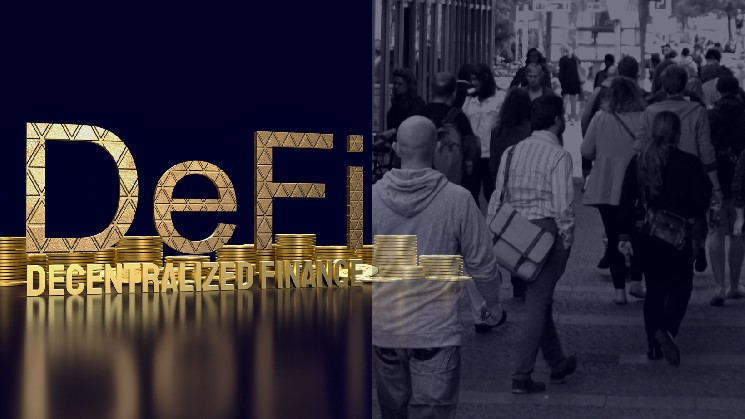DeFi still has a long way to go before mass adoption

The crypto and blockchain revolution has shown that decentralized finance can be a powerful tool to shape the digital economy. However, DeFi is more than just a buzzword. It’s an innovation born out of problems with traditional finance that have existed for centuries.
The traditional centralized finance model is about economic control rather than economic freedom. Almost 1.7 billion people worldwide don’t have access to critical financial services such as real-time transactions, loans and deposit schemes. Even those with access to traditional financial services suffer from a lack of mobility or need permission from third parties to use them. For instance, bank loans require high trust scores, deposit schemes have low interest rates, and real-time transactions are often limited to specific geographic locations and a lack of transparency.
DeFi solves a lot of these problems. It enables open access to anyone on the internet, facilitates wider income opportunities, establishes transparency and enables participation for everyone. The open-source protocols of decentralized finance are slowly but surely becoming an alternative to the banking sector.
However, DeFi lending still has a long way to go. Critical problems and limitations to the current DeFi ecosystem restrict mass-scale adoption.
Current problems with DeFi lending
Over the years, banks have established unsecured loans to allow users to borrow money based on their creditworthiness without locking up their assets. However, DeFi platforms still lack any scope for such services. There is currently no framework or solution for how credit-based lending or non-collateralized loans would work in a permissionless decentralized environment. Services such as unsecured loans require a centralized authority to determine an individual’s creditworthiness. So, the concept itself goes against the ethos of decentralized finance.
While a lot of established DeFi projects offer collateralized lending and borrowing, they often lack utility for all digital asset classes. For instance, most DeFi lending services only support top-tier tokens such as Bitcoin and Ethereum as collaterals. This means that the owners of lesser-known altcoins aren’t often able to access such services. Over US$50 billion of capital is locked in lower-ranked cryptocurrencies, yet their holders have limited opportunities in the DeFi ecosystem.
There’s also the issue of cross-chain interoperability. Different DeFi platforms offer their services on different blockchains. These blockchains represent separate and disparate environments, so investors or traders cannot freely access such services across other chains.
Cross-chain interoperability solutions exist, but they lack maturity and some have proved risky. Therefore, assets in the DeFi space remain less mobile across different blockchains, which increases costs for users and limits capital efficiency. For instance, if a user borrows crypto from a Solana blockchain-based platform and attempts to use it on the Ethereum blockchain, there will be high conversion and transaction fees. Ultimately this results in lost opportunities, as your capital is locked in a single network.
Capital efficiency is critical for DeFi ecosystems to reach full maturity. Crypto has the potential to be one of the most liquid assets in the financial domain. Increasing this liquidity will require crypto to become more seamlessly usable across different networks. So, DeFi platforms will need to establish cheaper and more secure cross-chain interoperability more widely across all cryptocurrencies.
The problems of regulation and compliance in DeFi
Regulatory pressure constantly challenges the scalability of DeFi services. As regulations in the decentralized space are still vague, constant changes can affect how services are offered and attained. As different countries have different regulations for the DeFi space, not every user can safely assume the same level of accessibility.
Furthermore, there’s a constant watershed between compliant and non-compliant DeFi. In theory, there are no regulations in the decentralized space, only digital extensions of the physical world’s regulations — which can’t often be mandated. There will always be some protocols that follow the regulations and some that don’t. However, compliant DeFi services will likely attain higher capital from users due to their ability to interact with regulated institutions.
Is the future bright for DeFi lending?
Although these problems exist in most DeFi protocols today, emerging platforms are developing new solutions. It’s important to understand that DeFi is still a very new and evolving space, and emerging projects can solve existing problems while making this space more accessible and sustainable. For example, next-generation DeFi services can provide non-collateralized loans by calculating credit through a user’s wallet history on the blockchain.
With the wider development of several layer-1 and layer-2 solutions, more DeFi protocols will likely support cross-chain interoperability and implement cross-chain solutions, meaning that users can lend stablecoins on one network and receive interest on another.
Conclusion
The future of DeFi lending is exciting. The global decentralized finance market is expected to reach US$231.19 billion by 2030 — a projected 42.5% year-to-year growth. This means more opportunities for sustainable and innovative DeFi lending and staking services to enter this space.
Many DeFi projects are also lowering the barriers of entry for new users. The growth of capital and the rate of project development are bound to solve a majority of the existing problems within the next few years. Once some of these key problems have been addressed by service providers, DeFi can potentially go toe-to-toe with traditional finance because of its functional benefits in terms of accessibility, transparency, security and reliability.






 Bitcoin
Bitcoin  Ethereum
Ethereum  Tether
Tether  USDC
USDC  Dogecoin
Dogecoin  TRON
TRON  Cardano
Cardano  Chainlink
Chainlink  Stellar
Stellar  Bitcoin Cash
Bitcoin Cash  LEO Token
LEO Token  Hedera
Hedera  Litecoin
Litecoin  Monero
Monero  Dai
Dai  OKB
OKB  Cronos
Cronos  Ethereum Classic
Ethereum Classic  Gate
Gate  VeChain
VeChain  Cosmos Hub
Cosmos Hub  Algorand
Algorand  KuCoin
KuCoin  Stacks
Stacks  Zcash
Zcash  Tether Gold
Tether Gold  Theta Network
Theta Network  IOTA
IOTA  Tezos
Tezos  TrueUSD
TrueUSD  NEO
NEO  Polygon
Polygon  Ravencoin
Ravencoin  Dash
Dash  Decred
Decred  Synthetix Network
Synthetix Network  Zilliqa
Zilliqa  Qtum
Qtum  0x Protocol
0x Protocol  Basic Attention
Basic Attention  Siacoin
Siacoin  Holo
Holo  DigiByte
DigiByte  Enjin Coin
Enjin Coin  Nano
Nano  Ontology
Ontology  Status
Status  Hive
Hive  Waves
Waves  Lisk
Lisk  Pax Dollar
Pax Dollar  Steem
Steem  Numeraire
Numeraire  NEM
NEM  BUSD
BUSD  Huobi
Huobi  OMG Network
OMG Network  Bitcoin Gold
Bitcoin Gold  Ren
Ren  Energi
Energi  Augur
Augur  Bitcoin Diamond
Bitcoin Diamond  HUSD
HUSD